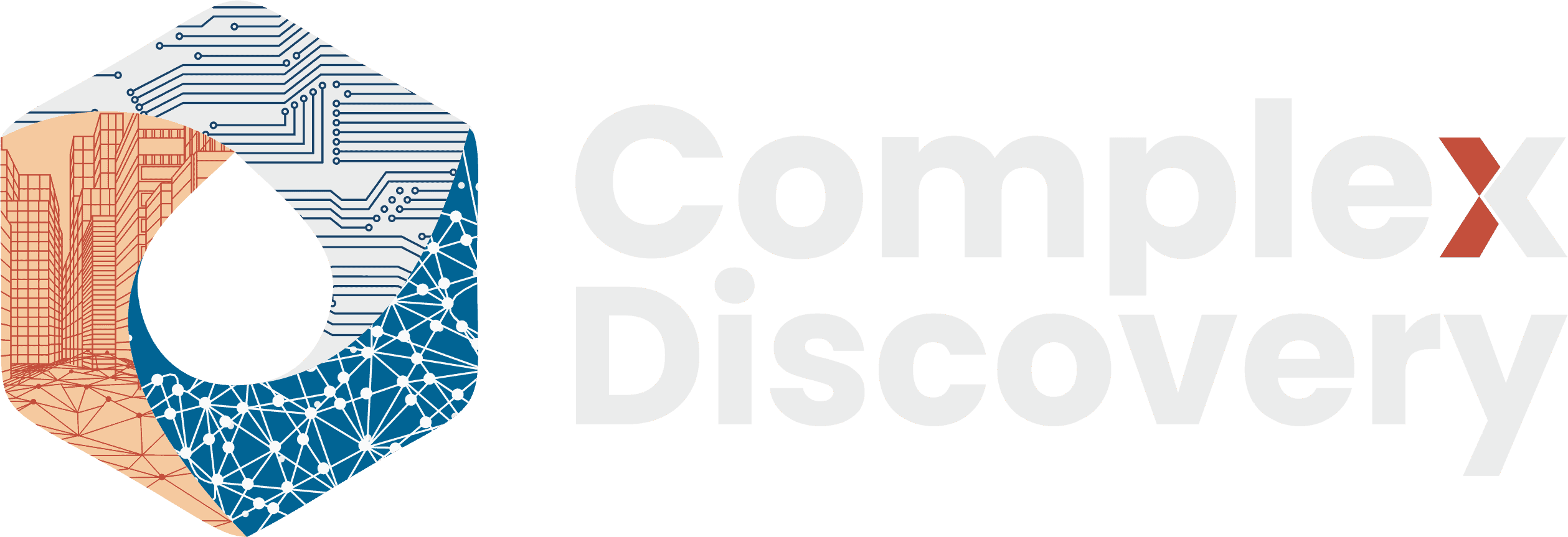Editor’s Note: Interim insights are no longer optional—they are essential. This nowcast from the 2H 2025 eDiscovery Business Confidence Survey, conducted by ComplexDiscovery and EDRM, blends real-time responses with rigorously modeled synthetic personas to surface directional intelligence while the survey remains open. With cautious optimism giving way to sharper scrutiny around GenAI ROI, the report captures a market in flux—shaped by tightening margins, disciplined investment, and strategic recalibration across legal technology. For cybersecurity, information governance, and eDiscovery professionals navigating complexity in real time, this nowcast delivers a clear, early signal of the forces shaping the end of 2025.
The 2H 2025 eDiscovery Business Confidence Survey remains open through November 2025. Your voice matters—whether you’re in a law firm, corporate legal department, service provider, consultancy, government entity, or technology vendor. Your confidential input (5-7 minutes) strengthens the final analysis and helps the entire industry understand where we’re heading. Take the survey at: eDiscovery Business Confidence Survey 2H 2025.
Content Assessment: Interim Signals: A Hybrid Nowcast of GenAI ROI and Market Caution in 2H 2025 eDiscovery
Information - 93%
Insight - 92%
Relevance - 93%
Objectivity - 91%
Authority - 90%
92%
Excellent
A short percentage-based assessment of the qualitative benefit expressed as a percentage of positive reception of the recent article from ComplexDiscovery OÜ titled, "Interim Signals: A Hybrid Nowcast of GenAI ROI and Market Caution in 2H 2025 eDiscovery."
Industry Research
Interim Signals: A Hybrid Nowcast of GenAI ROI and Market Caution in 2H 2025 eDiscovery
ComplexDiscovery Staff
As the final quarter of the year unfolds, ComplexDiscovery and EDRM continue to field responses for the 2H 2025 eDiscovery Business Confidence Survey. This interim analysis is based on 37 real-world responses, supplemented by 62 synthetic responses crafted through persona modeling. Far from speculative, these synthetic additions are deeply grounded in established patterns and distributions from both the current field period and the previously analyzed 1H 2025 survey. The goal of this early release is not to offer a definitive conclusion but to responsibly demonstrate how synthetic-panel techniques can enhance the speed, reach, and clarity of market intelligence—even while data collection is still underway.
The methodology behind this interim assessment involves a detailed approach to persona modeling. Ten archetype personas were developed to reflect the spectrum of roles and organizational contexts within the eDiscovery ecosystem, including law firms, service and software providers, corporate legal departments, consultancies, and public sector entities. Each persona’s attributes—ranging from seniority to technology adoption tendencies—were calibrated using historical data and real-time trends, ensuring that projections mirror not just numerical probabilities but also contextual market behavior.
In this preliminary snapshot, one theme dominates: the rising pressure to prove the return on investment for GenAI initiatives. While overall sentiment continues to lean toward optimism, particularly regarding current business conditions, there is a noticeable shift in tone. Respondents and persona-modeled participants alike express greater caution about the near-term future, especially as fiscal discipline tightens and margin compression continues to affect strategic decision-making. What once might have been approved based on technological promise now demands demonstrable efficiency, compliance, or cost savings before resources are committed.
This change is not occurring in isolation. Economic and policy factors are beginning to weigh more heavily across all segments. Public sector respondents in particular report that government procurement cycles are slowing, removing what was once a reliable source of demand stability. Vendors and consultancies note increased competitive pressure, often requiring them to not only deliver differentiated capabilities but also quantifiable outcomes—especially when it comes to GenAI.
At the same time, the panel’s composition suggests deeper shifts at play. The proportion of C-level and senior executive participation has increased, likely reflecting the heightened scrutiny GenAI investments are receiving from boards and financial stakeholders. As technology becomes more integral to core legal operations, decisions once confined to operational teams are now the focus of top-level leadership, driven by accountability to both performance and compliance standards.
Despite these headwinds, GenAI adoption remains on an upward trajectory, though the criteria for investment have evolved. Legal departments and service providers alike are gravitating toward solutions that are practical, scalable, and defensible—those that deliver on accuracy, efficiency, and explainability. The field is moving past an era of exploratory pilots and toward more deliberate implementation strategies, supported by stronger governance models and measurable KPIs.
This nowcast makes clear that the industry is not retreating from innovation but is becoming more disciplined in how it defines, deploys, and measures it. The survey findings to date suggest that legal technology leaders are increasingly focused on the operational realities of transformation—cost control, client retention, and regulatory navigation—rather than relying on broad promises or theoretical gains.
These insights, while valuable, remain interim and directional. They offer a transparent lens into the evolving dynamics of legal technology as 2025 draws to a close, and they set the stage for a more comprehensive, fully validated analysis to follow once the survey concludes in November. By presenting early intelligence through a blend of field data and statistically grounded modeling, this approach provides a benchmark for responsible, rapid-cycle reporting in a sector where timeliness and accuracy are equally critical.
ComplexDiscovery and EDRM will publish the full results of the 2H 2025 eDiscovery Business Confidence Survey upon survey close, offering a complete view of sentiment, strategy, and signal across the legal tech landscape. Until then, this interim analysis offers both insight and invitation—a real-time glimpse into what the future may hold and a call for professionals across the field to make their perspectives part of the final picture.
FAQ: Understanding the Interim 2H 2025 eDiscovery Business Confidence Survey
Q1: What makes this report different from traditional survey results?
This is an interim “nowcast” analysis, not a complete survey report. It combines 37 real survey responses (as of late October 2025) with 62 AI-generated synthetic responses to demonstrate how emerging research methods can provide early trend visibility during active survey periods. Traditional survey reports wait until data collection is complete.
Q2: What is a synthetic panel, and why was it used?
A synthetic panel combines real survey responses with AI-generated responses from personas modeled on real-world sector roles and expertise. This experimental approach enables trend analysis before survey completion. Personas are designed based on industry expert profiles and known role distributions documented in ComplexDiscovery and EDRM historical data. The goal is to demonstrate whether this methodology can provide credible early indicators while being fully transparent about its limitations.
Q3: How are the 99 responses distributed between real and synthetic data?
The dataset consists of 37 real responses from the 2H 2025 survey (as of late October 2025), 62 synthetic responses generated via persona modeling. Each record is distinctly labeled by source type. Proportions were managed to reflect the anticipated real-world sector balance.
Q4: How were the synthetic personas created?
Ten personas were developed representing typical industry roles—law firm partners, service provider executives, corporate counsel, consultants, government specialists—reflecting actual market segments documented in ComplexDiscovery and EDRM data from both 1H and 2H 2025. Response tendencies were determined using probability weights derived from current real respondent distributions and validated historical patterns.
Q5: What validation was performed on the synthetic data?
Statistical validation included chi-square significance testing to confirm that synthetic responses plausibly matched real survey data distributions across primary variables. Segment and role splits were benchmarked against known industry patterns from both the current survey cycle and the comprehensive 1H 2025 results. However, these validation steps cannot eliminate the fundamental limitation that synthetic responses represent modeled scenarios rather than authentic market voices.
Q6: How were economic themes incorporated into the analysis?
Response weights and narrative prompts for relevant personas were calibrated to reflect increased attention to “proving ROI,” competitive pressure, and government spending concerns, based on documented market shifts, industry analysis, and patterns observed in the 1H 2025 survey. This calibration introduces potential confirmation bias and is a key limitation of the methodology.
Q7: What are the significant limitations of this approach?
Critical limitations include only 37 real responses as foundation (ongoing collection), 63% of dataset is AI-generated projections, not authentic market voices, synthetic responses may reflect researcher expectations or biases, findings are directional projections, not deterministic results, final results may shift substantially as real responses accumulate, this is not peer-reviewed research or a scientific study, and synthetic methodology is experimental and requires further validation.
Q8: Why publish an interim projection rather than waiting for complete data?
This report serves two purposes: (1) providing early directional signals for industry stakeholders who may find provisional insights useful for planning, and (2) transparently demonstrating and testing an emerging research methodology. Publishing interim findings with full disclosure allows the industry to evaluate both the utility and limitations of this approach. In a rapidly evolving sector, timely intelligence—even if provisional—can inform strategic conversations that cannot wait for final results.
Q9: When will final survey results be published?
Complete analysis incorporating all survey responses will be published after the survey closes in November 2025. The final report will include comparative analysis showing how preliminary projections aligned with or diverged from complete survey results—providing valuable learning about this methodology’s effectiveness.
Q10: Should organizations make strategic decisions based on this report?
This report should be treated as one of many inputs for strategic thinking, not as a definitive market study. Organizations should combine these preliminary indicators with their own market intelligence, client feedback, and business data. The final comprehensive survey report will provide more reliable insights for strategic decision-making.
Q11: Can I still participate in the survey?
Yes! The survey remains open through November 2025, and we strongly encourage all eDiscovery professionals to participate to ensure the final analysis reflects the full diversity of industry perspectives. Your participation directly improves the quality and representativeness of the final report.
For questions or feedback about the survey or this experimental methodology, please contact the ComplexDiscovery editorial team at info@complexdiscovery.com.
Narrative Data Structure Appendix
The dataset for this analysis contains 99 entries, flagged by origin (real or synthetic) and complete for all major fields: business segment, sentiment, near-term outlook, financial and operational expectations, technology adoption, and risk factors. The core persona set was specifically constructed to track the mix as recorded in both the 1H and 2H 2025 cycles, with sector, seniority, and adoption status calibrated to market realities.
Primary Variables Captured:
- Data Source Identifier (Real Response or Synthetic Response)
- Business Segment (Law Firm, Corporate Legal, Service/Software Provider, Consultant, Government, Academic, Media/Research, Other)
- Current Business Conditions (Excellent, Good, Normal, Concerning, Poor)
- 6-Month Outlook (Better, Same, Worse)
- Revenue Expectation for 6 months (Higher, Same, Lower)
- Profit Expectation for 6 months (Higher, Same, Lower)
- Top Business Issue/Challenge (Budgetary Constraints, Increasing Types of Data, Increasing Volumes of Data, Data Security, Inadequate Technology, Lack of Personnel, Proving GenAI ROI, Competitive Pressure, Economic Uncertainty, Government Spending Slowdown)
- Geographic Region of Operations
- Primary Function in Organization (Legal, Technology/IT, Operations/Litigation Support, Business/Business Support)
- Support Level (Executive Leadership, Operational Management, Tactical Execution)
- GenAI/LLM Adoption Status (Integrating and Deploying, Testing and Piloting, Considering and Evaluating, No Plans)
- Primary Benefit from GenAI/LLM (Competitive Advantage, Improved Service/Product Delivery, Cost Savings, Decision Support, Other)
- Primary GenAI/LLM Challenge (Result Accuracy, Unclear ROI, Regulatory/Privacy Compliance, High Costs, Skills Gap, Other)
- DSO Trajectory (Unfluctuating, Increasing, Decreasing, Do Not Know)
- MRR Trajectory (Unfluctuating, Increasing, Decreasing, Do Not Know)
- Revenue Distribution Across Customer Base (Increasing, Unfluctuating, More Concentrated, More Distributed, Do Not Know)
- Additional Comments (real responses only, when provided)
Every variable used for modeling is documented for transparency and potential audit in future cycles. The methodology described herein is itself part of the field’s evolving rigor and professionalism.
Assisted by GAI and LLM Technologies
Additional Reading
- eDiscovery Business Confidence Survey 2H 2025
- 1H 2025 eDiscovery Business Confidence Survey Results Released by ComplexDiscovery OÜ and EDRM
- eDiscovery Surveys Archives – ComplexDiscovery
Source: ComplexDiscovery OÜ



























